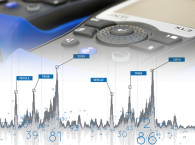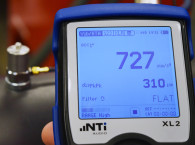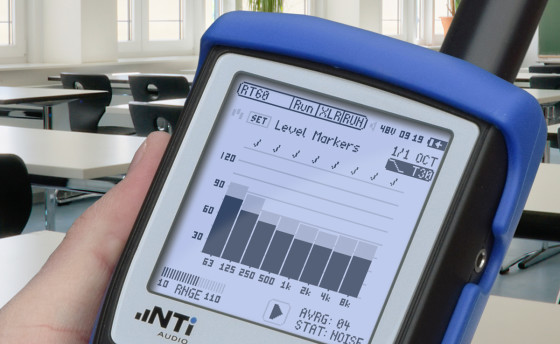
A reverberation time RT60 measurement represents the time taken for the sound level in a room to drop by 60 dB, after the sound source is suddenly removed. The XL2 employs a Schroeder reverse integration method to measure the RT60 reverberation spectrum in octave bands from 63 Hz to 8 kHz. The optional “Extended Acoustic Pack” increases the measurement resolution to 1/3rd octave bands in the range from 50 Hz to 10 kHz.

The determination of reverberation time in a room is important for several reasons. Firstly, it positively or negatively affects the intelligibility of speech, as well as the timbre of music. RT60 values most appropriate to the function of the room are desirable. Further, reverberation time values are required for the calculation of various parameters, such as the sound insulation of walls or the sound power of noise-generating products.
According to the ISO3382 standard, reverberation time can be determined using various measurement methods. The XL2 now offers two such methods; the new T30 method and the current T20 method. The procedure to measure reverberation with both methods is simple. With the T30 measuring method, the XL2 Acoustic Analyzer measures the time for a sound level to drop by 30 dB, while the T20 method measures a drop of 20 dB. These measured values are then extrapolated to 60 dB.
The T20 method is used in circumstances where a smaller dynamic range and a lower signal level is appropriate. The T30 method achieves more precise reverberation times and increases accuracy in linear sound decay.
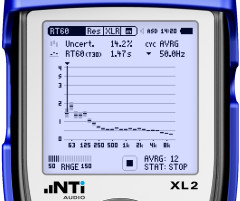
Either an impulse or a gated noise can be used as the sound source. A starter pistol, a clapper board or a bursting balloon are typical impulse sound sources. The XL2 Acoustic Analyzer triggers on the impulse and automatically measures the RT60 reverberation time. For precise measurements using gated noise, such as pink noise, loudspeakers with an omnidirectional radiation pattern are recommended.
NTi Audio offers the Dodec Set DS2 as an ideal, cost-effective solution for accurate reverberation measurements. The DS2 fills the room uniformly with acoustic energy. The XL2 automatically performs a series of measurements cycles, calculating the RT60 average in each frequency band. In each measurement cycle, the XL2 provides additional information on the linearity of the decaying sound level, and, after three measurement cycles, the measurement uncertainty is displayed as a percentage. These calculations and additional information are all in accordance with the ISO3382 standard.
Any XL2 can be extended for the reverb measurement in 1/3rd octave resolution with the optional “Extended Acoustic Pack”. Advanced reverberation time measurement is available with the XL2 firmware Version 3.03 and is free for all XL2 customers.
New Low Frequency Noise assessment
The Data Explorer PC software for the XL2 Sound Level Meter now includes also a series of professional tools for detailed analysis of low-frequency noise (LFN). The graphical representation of time varying frequency components offers an efficient process for identifying the presence and level of LFN. Also the associated high quality audio recording supports further correlation with the objective measurement data.
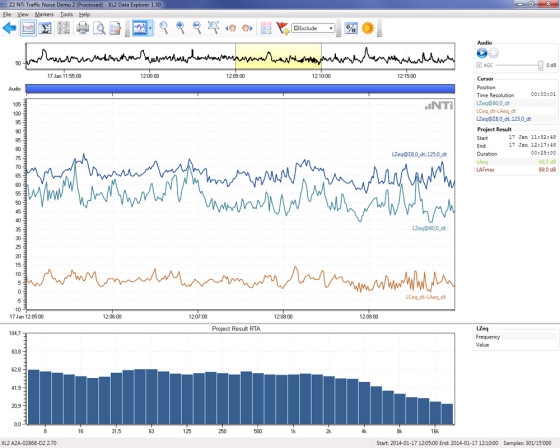
The new features are particularly useful in the calculation of immission levels which is defined as the cumulative noise energy to which an individual is exposed over time. Exposure to low-frequency noise over extended periods can lead to a range of health problems including cardio vascular disease, insomnia and depression. The sources of low frequency noise can often be attributed to electricity sub stations, chiller plants and incinerators with continuous noise at frequencies below 200 Hz.
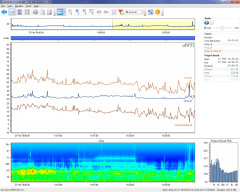
Measuring LFN requires a class 1 sound level meter, such as the XL2 in combination with the M2230 measurement microphone. The XL2 stores all measured levels and audio recordings continuously on the removable SD card. After completion of the measurement, the data can be easily imported into the Data Explorer software for comprehensive analysis of the low-frequency characteristics and calculation of the noise immission levels.
The XL2 Sound Level Meter already calculates and displays the live broadband level difference LCeq-LAeq onsite during the recording. When the measurement is completed, the Data Explorer software graphically displays this difference simultaneously over the entire measurement period. A difference exceeding locally defined dB limits is a clear indication that there is excessive energy in the low-frequency range of the spectrum. A more detailed analysis can then be undertaken by examining the individual one-third octave bands over time.
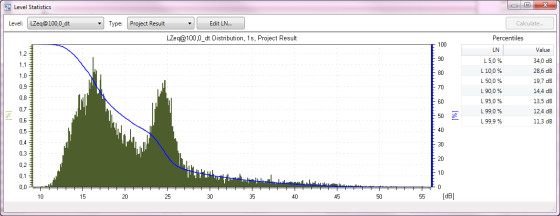
By selecting one or more, or a range of one-third octave bands for display against time - for example, choosing the range 8 - 125 Hz - allows the user to see how much energy was produced in these frequencies and whether an on/off pattern can be identified which corresponds with the operational behavior of near-by machinery. The extensive analysis capabilities of the Data Explorer also allow the calculation of level statistics on these individual bands.
The correlation of the objective measurements with the subjective sound recording further validates the analysis. Therefore the class 1 XL2 Sound Level Meter in combination with the Data Explorer software provides a professional solution for the everyday demands of acousticians assessing environmental noise.
The new low-frequency analysis features are part of the Data Explorer V1.30 release, which is now available for download, free of charge to all licensed users. An XL2 with the optional Extended Acoustic Pack provides onsite the broadband level difference calculation LCeq-LAeq along with the linear high quality sound recording capability so useful for the subjective assessment.
www.nti-audio.com/en/products/xl2-sound-level-meter.aspx



